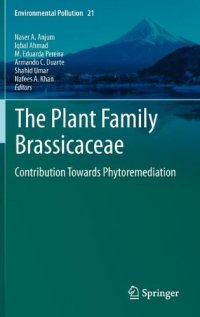
Ebook: The Plant Family Brassicaceae: Contribution Towards Phytoremediation
- Genre: Biology // Ecology
- Tags: Environmental Engineering/Biotechnology, Pollution general, Environmental Management, Plant Sciences, Sustainable Development
- Series: Environmental Pollution 21
- Year: 2012
- Publisher: Springer Netherlands
- Edition: 1
- Language: English
- pdf
With the advent of the industrial revolution , the biosphere has been continuously polluted with a myriad of contaminants that urgently need global attention. In this perspective, most of the genera of the plant family Brassicaceae (Crucifereae or the mustard family) are a significant part of the plants- and associated microbes-based strategies adopted for the cleanup of varied contaminants from environmental compartments. Important genus such as Alyssum, Arabidopsis, Brassica and Thlaspi from Brassicaceae which, besides acting as an attractive genetic model, well-represent the metal hyperaccumulation among approximately 0.2% of all angiosperms and thus, play a key role in the phytoremediation technology. This book i) provides an exhaustive evaluation of the current status of contaminants (metals/metalloids)-addition to varied environmental compartments and its consequences, ii) offers comprehensive and state-of-the-art information on the significance of the plants from the family Brassicaceae in solving environmental pollution issues, iii) examines the physiological, biochemical and molecular-genetic strategies adopted by the plants from Brassicaceae for the remediation of and tolerance to varied environmental contaminants, and iv) supplies a broad reference to the field of environmental science and related disciplines. As a pioneer work and significant addition to the Environmental Pollution book series, the current volume promises to be a useful asset for researchers, students, other academicians and policy makers involved in sustainable remediation of varied environmental compartments.
With the advent of the Industrial Revolution, the biosphere has been continuously polluted with a myriad of contaminants that urgently need global attention. In this perspective, most of the genera of the plant family Brassicaceae (Crucifereae or the mustard family) are significant parts of the plants- and associated microbes-based strategies adopted for the cleanup of varied contaminants from environmental compartments. Important genera such as Alyssum, Arabidopsis, Brassica and Thlaspi from Brassicaceae which, besides acting as attractive genetic models, well-represent the metal hyperaccumulation among approximately 0.2% of all angiosperms and thus, play a key role in the phytoremediation technology. This book i) provides an exhaustive evaluation of the current status of contaminants (metals/metalloids)-addition to varied environmental compartments and its consequences, ii) offers comprehensive and state-of-the-art information on the significance of the plants from the family Brassicaceae in solving environmental pollution issues, iii) examines the physiological, biochemical and molecular-genetic strategies adopted by the plants from Brassicaceae for the remediation of and tolerance to varied environmental contaminants, and iv) supplies a broad reference to the field of environmental science and related disciplines. As a pioneer work on the subject and significant addition to the Environmental Pollution book series, the current volume promises to be a useful asset for researchers, students, other academics and policy makers involved in sustainable remediation of varied environmental compartments. The Plant Family Brassicaceae: An Introduction / Naser A. Anjum, Sarvajeet S. Gill, Iqbal Ahmad, M. Pacheco and Armando C. Duarte, et al. -- Current Status of Toxic Metals Addition to Environment and Its Consequences / Qaisar Mahmood, Audil Rashid, Sheikh S. Ahmad, Muhammad R. Azim and Muhammad Bilal -- Cadmium Accumulation by Plants of Brassicaceae Family and Its Connection with Their Primary and Secondary Metabolism / Petr Babula, Vojtech Adam, Ladislav Havel and Rene Kizek -- Metal Hyperaccumulation and Tolerance in Alyssum, Arabidopsis and Thlaspi: An Overview / Sarvajeet S. Gill, Naser A. Anjum, Iqbal Ahmad, P. Thangavel and G. Sridevi, et al. -- Brassica Rhizosphere-Microbe Interactions and Their Role in Phytoremediation / Mushtaq Ahmed, V. K. Singh and R. S. Upadhyay -- Phytoremediation of Heavy Metals by Brassica juncea in Aquatic and Terrestrial Environment / Anamika Singh and M. H. Fulekar -- Toxic Metals Accumulation, Tolerance and Homeostasis in Brassicaoilseed Species: Overview of Physiological, Biochemical and Molecular Mechanisms / Vinay Kumar, Monika Mahajan and Sudesh K. Yadav -- The Role of Plant Growth-Promoting Rhizosphere Bacteria in Toxic Metal Extraction by Brassica spp. / Oguz C. Turgay and Serdar Bilen -- Biochemical and Functional Responses of Arabidopsis thaliana Exposed to Cadmium, Copper and Zinc / Adriano Sofo, Antonio Scopa, Tony Remans, Jaco Vangronsveld and Ann Cuypers -- Brassicas in Turkey and Their Potential Role for Degraded Habitats' Remediation / Munir Ozturk, Abdul R. Memon, Salih Gucel and M. Serdal Sakcali -- Chelate Assisted Phytoextraction Using Oilseed Brassicas / Firdaus-e-Bareen -- Roles of Rhizospheric Processes and Plant Physiology in Applied Phytoremediation of Contaminated Soils Using Brassica Oilseeds / Sarah Neilson and Nishanta Rajakaruna.